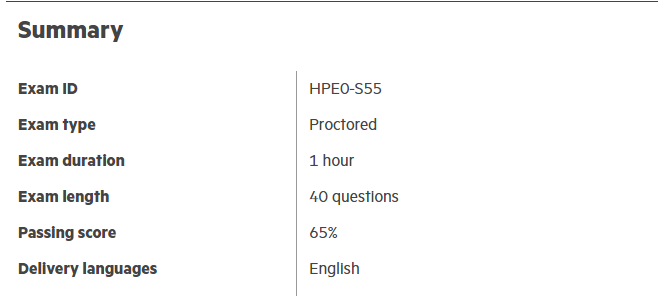HPE ASE HPE0-S55 Dumps - Delta - Designing HPE Server Solutions
There are many ways to help you pass HPE0-S55 Delta - Designing HPE Server Solutions exam. PassQuestion HPE ASE HPE0-S55 Dumps can provide you a good training tool and high-quality reference information for you to participate in the HPE0-S55 exam. PassQuestion HPE ASE HPE0-S55 Dumps are based on the research of HPE0-S55 examination Outline. Therefore, the high quality and high authoritative information provided by PassQuestion can definitely do our best to help you pass HPE0-S55 exam.

HPE0-S55 Exam Overview - Delta - Designing HPE Server Solutions
The Minimally Qualified Candidate (MQC) for Server Architect at the Accredited System Engineer (ASE) level has advanced knowledge of HPE solutions and underlying technologies, which include CPU, memory, disk, power, networking, management subsystems, data center environments, and multi-site configurations. The typical MQC will have worked in the IT industry in an HPE server environment for at least 18 to 36 months.

Ideal candidate
The MQC is able to interpret detailed information provided by the customer to make complex judgments on customers’ needs for both the present time as well as anticipated future growth. The MQC is able to navigate through the HPE server solution offerings to identify, describe, position, and specify an appropriate solution. The MQC also is able to communicate the purpose, function, market positioning, and capabilities of HPE solutions and services.
Exam Objectives
This exam validates that you can perform critical job tasks including, but not limited to:
55% Plan and Design Solutions
- Based on the customer's goal, determine the appropriate information to gather from the customer.
- Given a scenario, determine an appropriate tool to size, specify, or build a solution.
- Given a scenario, describe how to generate the customer proposal (for example, Bill of Materials, TCO Report, diagrams, Quote, third-party items, power and cooling statistics).
- Given a scenario, identify potential design issues with the customer's existing environment.
- Determine under which circumstances an architect would propose specific industry standard server, storage, network architectures and technologies.
- Given a customer's long-term vs short-term needs, determine a solution with a possible upgrade path.
- Given a scenario, describe the service offerings that meet the business and IT objectives.
- Analyze customer information to determine the gap between the existing customer environment and the documented customer needs.
- Compare and contrast available HA and DR solutions, match them with the customer's business needs, and available budget.
- Provide a rationale for a product line within a given solution.
- Given a scenario, map the solution benefits to the original customer requirements and respond to customer objections raised by key stakeholders.
20% Install, Configure, and Set Up, Solutions
- Evaluate the customer environment to determine POC suitability. (site specific/scenario based)
- Analyze the success criteria and proposed POC solution to determine the gap between them.
- Describe the steps for implementing the design.
- Determine how the design achieves the customer's technical requirements and highlight additional improvements identified during design implementation.
10% Troubleshoot Solutions
- Given a customer problem, determine an appropriate resolution path.
- Explain how to use the appropriate tools to identify a problem.
- Describe the correlation between a remediation and its predicted outcome.
15% Manage, Monitor, and Maintain Solutions
- Given a customer situation, identify the appropriate management tool to use.
- Describe the steps for performing common management tasks.
- Interpret collected data for lifecycle management operations.
- Interpret collected data to optimize performance and availability.
View Online Delta - Designing HPE Server Solutions HPE0-S55 Free Questions
1. While installing a three frame Synergy solution, only two of the frames are identified during the discovery process.
What should you do to get resolution?
A. Remove and re-insert the standby Composer
B. Issue a refresh command to the enclosure
C. Open the front panel of the Composer, and read the error message
D. Validate Frame Link Module topology
Answer: D
2. What is required to enable Jitter Smoothing technology? (Choose two.)
A. HPE Apollo
B. ProLiant Gen 10
C. HPE Synergy
D. HPE Cloudline
E. iLO5 Advanced
Answer: B,E
3. A customer is using HPE Smart Update Manager (SUM) for firmware update. They plan to add 100 Gen10 ProLiant servers, and they are concerned about whether HPE SUM will be able to support this size of installation.
What other option could the customer use for firmware updates that has increased scalability?
A. iLO Advanced Premium Security Edition
B. Insight Control server provisioning
C. Insight Cluster Management Utility
D. iLO Amplifier Pack
Answer: D
4. A customer purchased HPE ProLiant Gen10 servers. The customer is transitioning from a physical to a virtual environment.
Which feature should be enabled to ensure that they get the optimal performance from their new servers?
A. UEFI optimized boot
B. Integration with an HPE OneView for VMware vCenter
C. Performance optimization using the workload profiles
D. OneView OS Build Plan
Answer: C
- TOP 50 Exam Questions
-
Exam
All copyrights reserved 2025 PassQuestion NETWORK CO.,LIMITED. All Rights Reserved.

